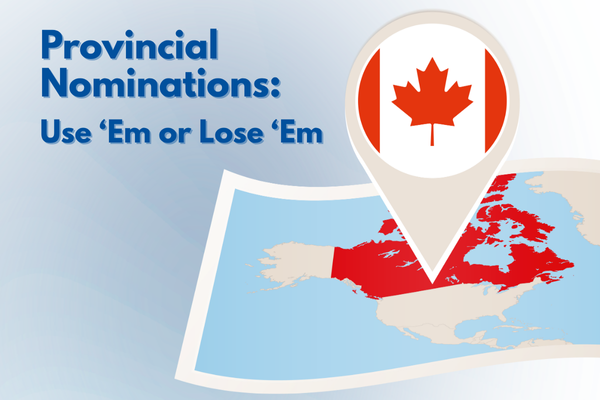End-of-Year Immigration & Work Permit Updates

As provinces work to use up their remaining 2025 nominations and travel-based permit applications gain popularity, it’s never been more important to plan ahead, both for employers and workers.
Provincial Nominations Have Returned
Provinces across Canada have received some of their unused nominations back, meaning more opportunities for both employers and applicants. We encourage you to check each province’s immigration website for updates as they begin issuing these newly available spots.
From experience, government programs operate on a “use it or lose it” basis. Provinces that don’t use their full nomination allotment may receive fewer in future years. With the end of the year approaching and a potential reset of nomination quotas, most provinces will be working to allocate every remaining nomination before 2026.
In Saskatchewan, where the program previously closed after reaching capacity, the province is now creating a list of employers and contacting them to confirm whether positions are still needed. This allows them to issue Job Approval Letters (JALs) and proceed with nominations.
If you’re an employer in Saskatchewan who hasn’t yet joined the queue, now is the time to get your name on that list.
Holiday Work Permit Applications to Work in Canada
Holiday Port of Entry Applications are a new and growing trend, and I believe we’ll see a steady increase in these for those who qualify. Traditionally, people would go to the nearest land border to obtain a new work permit based on their LMIA, nomination, PR in process or an applicable exemption.
However, beginning in 2025, land borders will no longer be able to issue work permits, which makes Holiday Port of Entry applications a new and viable option.
It’s important to note that people previously had the opportunity to apply for work permits from within Canada, so this wasn’t a problem. That option has also been removed, further reinforcing the relevance of Holiday Port of Entry applications for work permits.
If you're from a country not listed below, you’ll need to apply for a new work permit and cannot use a Port of Entry to obtain a decision without submitting an application. In that case, your options are to apply from your country of citizenship or from a country where you are legally permitted to be and currently present.
This introduces the concept of the Holiday Application, many destinations now have quick work permit processing times. By applying online after you land, you can enjoy a short warm (or cold) holiday while waiting for a decision on your new work permit.
Individuals from the countries listed below are able to apply for a work permit upon entry, based on holding an eTA. There are two main groups to consider:
- Visa-exempt countries that can always apply upon entry, and2.
- Conditionally visa-exempt countries, where eligibility depends on the applicant having held a Canadian visa within the past 10 years or currently holding a valid U.S. non-immigrant visa.
In my opinion, it would be wise to stay at least a day or two as part of your holiday so that it’s not blatantly obvious that you are “Holiday Flag Poling.” Take the opportunity to genuinely enjoy a short holiday before obtaining your work permit to return to Canada.
For individuals who are not from a visa-exempt country, check which countries you are legally permitted to travel to and how long you can stay there. Then, review how long it takes to obtain a work permit from that location if you’d prefer not to return to your home country to apply.
For employers:
If you have a worker whose status has expired or who has gone out of status, and that worker entered under a Dual Intent LMIA, you are not required to pay for the flight home or to another country they choose (as long as both parties agree).
For Low-Wage LMIA applications, however, it’s important that employers do pay for the return flight, so speak with your employee or applicant in advance to confirm costs and ensure this is arranged.
Lastly, applying for a work permit while traveling does not guarantee approval. A strong and professionally prepared application is always recommended. Ultimately, the immigration officer has the discretion to make the final decision. So feel free to reach out to the team at Fill
a Role
before hand to get assistance and a second-opinion.
TABLE 1: VISA-EXEMPT COUNTRIES (eTA Eligible)
| Andorra | Finland | New Zealand |
| Australia | France | Norway |
| Austria | Germany | Papua New Guinea |
| The Bahamas | Greece | Poland |
| Barbados | Hong Kong SAR (passport issued by Hong Kong SAR) | Portugal |
| Belgium | Hungary | Romania (electronic passport only) |
| British citizen* | Iceland | Samoa |
| British National (Overseas) | Ireland | San Marino |
| British overseas citizen (re-admissible to the UK) | Israel (national passport) | Singapore |
| British overseas territory citizen (Anguilla, Bermuda, BVI, Cayman Islands, Falkland Islands, Gibraltar, Montserrat, Pitcairn Island, Saint Helena, Turks and Caicos Islands) | Italy | Slovakia |
| British Subject with right of abode in the UK | Japan | Slovenia |
| Brunei Darussalam | Republic of Korea | Solomon Islands |
| Bulgaria | Latvia | Spain |
| Chile | Liechtenstein | Sweden |
| Croatia | Lithuania | Switzerland |
| Cyprus | Luxembourg | Taiwan (passport issued by MOFA Taiwan with personal ID number) |
| Czech Republic | Malta | United Arab Emirates |
| Denmark | Monaco | Vatican City State (passport/travel document issued by the Vatican) |
| Estonia | Netherlands |
TABLE 2: CONDITIONAL VISA-FREE COUNTRIES (Eligible if holder of a valid U.S. non-immigrant visa OR past Canadian visa within 10 years)
| Antigua and Barbuda | Philippines | Seychelles |
| Argentina | St. Kitts and Nevis | Thailand |
| Costa Rica | St. Lucia | Trinidad and Tobago |
| Morocco | St. Vincent and the Grenadines | Uruguay |
| Panama |


